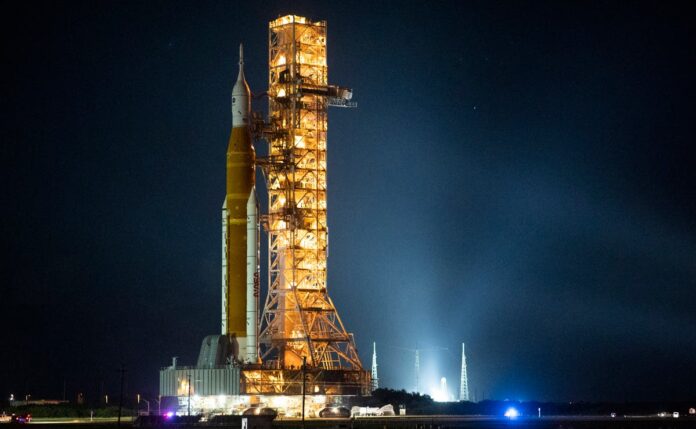Thursday night brought the first opportunity for Nasa technicians to examine the space agency’s big Moon rocket, following Hurricane Nicole, which subjected the rocket to powerful winds.Friday afternoon will see Nasa test the Space Launch System (SLS) rocket and Orion spacecraft by powering them on and making minor repairs, according to a Twitter post by Nasa’s Associate Administrator for Exploration Systems Development Jim Free. He noted that initial inspections Thursday night showed minor damage to the SLS rocket, such as ‘loose caulk and tears in weather coverings.’Nasa had been targeting Monday, 14 November as the next launch attempt for SLS and the space agency’s Artemis I mission, but delayed that launch until 16 November when it became clear then-Tropical Storm Nicole would interfere with the earlier launch attempt. By the time the forecasts changed and it became clear Nicole could strengthen into a hurricane, it was too late to roll the SLS back into its hangar at Kennedy Space Center in Florida, and so the roughly $4bn rocket rode out the hurricane while sitting in the open on launch pad 39B at Cape Canaveral Space Force Station.Just prior to Nicole’s strengthening to a hurricane, Nasa issued a statement saying the SLS was rated to handle wind gusts of up to 85-miles-per-hour. In a Tweet, Mr Free said Nasa’s sensors at the launch pad detected wind gusts as high as 82 miles-per-hour 60 feet high at the launch pad.The SLS rises 322 feet into the air, however, and meteorologists noted on Twitter that some sensors showed wind gusts of greater than 85-miles-per-hour at times during Hurricane Nicole’s passage. Orlando WESH 2 TV news meteorologist Eric Burris, for instance, pointed to sensor readings at the launch pad recording nearly 100-mile-per-hour winds at a height of 200 feet.Whether these gusts did lasting damage to the SLS remains to be seen, but Mr Free plans to hold a press conference Friday at 3pm EST to discuss Nasa’s findings.SLS and Orion are the cornerstones of Nasa’s Artemis Moon program, which seeks to put humans back on the Moon in 2025 and build a lasting presence on the lunar surface. The first mission of the program, Artemis I, is an essential uncrewed test flight for the SLS rocket and Orion, with the former pushing the latter on a course to, around and beyond the Moon before Orion returns to Earth to tests it’s heat shield and parachutes during reentry and a splash down in the Pacific Ocean.Artemis I has been delayed multiple times, with Nasa scrubbing the first and second launch attempts in August and early September following technical problems. Hurricane Ian and now Hurricane Nicole have created further delays.If Artemis I ever gets off the ground and is successful, Artemis II will see four astronauts fly around the Moon in an Orion spacecraft in May 2024. Artemis III, scheduled for sometime in 2025, will then see two Nasa astronauts set foot on the Moon for the first time since 1972.


